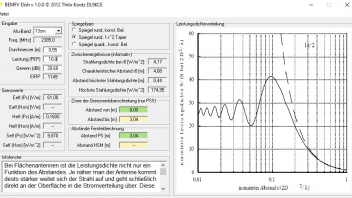I think I got it ...
(screen shots with courtesy of Thilo, DL9KCE)
The experimental tool BEMFVDish.exe from DL9KCE (DARC website for member) verifies that the liniear calculation for the power flux density (PFD) assuming a far field situation can be applied even for smaller distances (under certain limits). Taking the exposure limit of 61 V/m into account lead to the following results.
DK8KW: 1.9 m dish, G=31.4 dBi, PEP=47,3 W
=> safe distance of 23 m (with respect to the center of the main lobe)

DF6LO: 0.55 m dish, G=20.6 dBi, PEP=10 W
=> safe distance of 3 m (with respect to the center of the main lobe)

DL9KCE's tool shows an estimation for the beginning of the far field (r0 = 2D²/lambda ("normierter Abstand"), D=diameter of antenna). You can find this as well for instance here http://www.radartutorial.eu/06.antennas/an60.en.html .
Interesting to see is, that the bigger the dish and the higher the frequency, the larger the distance to the beginning of the far field region. Even more interesting that the maximum PFD (Smax) is higher for a smaller dish and lower power. See the oscillating PFD in the near field region.
DK8KW: Far field starts at r0 = 56 m with PFD=1.66 W/m² (center of main lobe)
-> level exaltation of about 41 at 0.1xr0=5.3 m
=> Smax=70 W/m² (not fully clear where)
DF6LO: far field starts at r0 = 4.7 m with PFD=0.44 W/m² (center of main lobe)
-> level exaltation of about 41 at 0.1xr0=0.44 m
=> Smax=175 W/m² (not fully clear where)
My earlier assumption regarding the beginning of the far field region with r0 = 10xlambda = 1.25 m is not correct for a parabolic dish. So for DK8KW's setup the 60 kW EIRP is correct but not the PFD with S=3000 W/m² at 1.25 m.
So actually you can't use the far field formulas but when you look at the diagram (BEMFVDish on the right) you notice that at 0.2 x r0 the deviation is very small. But for distances below that, one has to consider the near field and transition zone.
Now at the end one have to consider the height of the antenna and the elevation of the main beam of 28.5° (for central Germany, see the sketch in post from DK8KW). I guess we can neglect the side lobes. Regarding the beam width I was too lazy to use the formulas but looked for online calculators.
http://www.satsig.net/pointing…-beamwidth-calculator.htm
https://www.tracking-antenna.d…as/beam-width-calculator/
1.9 m dish, 2.4 GHz, efficiency 0.6, 31.4 dBi
-3 db +/-2.39°
-6 dB +/-3.39°
0.55 m dish, 2.4 GHz, efficiency 0.6, 20.6 dBi
-3 dB +/-8.27°
-6 dB +/-11.7°
-6 dB reduces the safe distance to half the value calculated for the center of the main lobe (see above).
DK8KW: 23 m/2 = 11.5 m
DF6LO: 3 m/2 = 1.5 m
A little bit of trigonometry lead to ...
DK8KW: Antenna height 2 m, -6 dB at (28.5°-3.39° = 25.11°) elevation
=> at a horizontal distance of 10.4 m the exposure limit is reached at a height of 6.9 m = (2 + 4.9) m
DF6LO: Antenna height 1.5 m, -6 dB at (28.5°-11.7° = 16.8°) elevation
=> at a horizontal distance of 1.44 m the exposure limit is reached at a height of 1.93 m = (1.5 + 0.43) m
... or with respect to the center of the main lobe...
=> at a horizontal distance of 2.64 m the exposure limit is reached at a height of 2.93 m = (1.5 + 1.43) m
So everything is safe with respect to DK8KW's and my contollable areas.
DK8KW's setup with 750 mW -2 dB = 473 mW doesn't exeed the exposure limit at all.

I wonder if the results of the current so called experimental tool BEMFVDish.exe will be accepted by the BNetzA.

